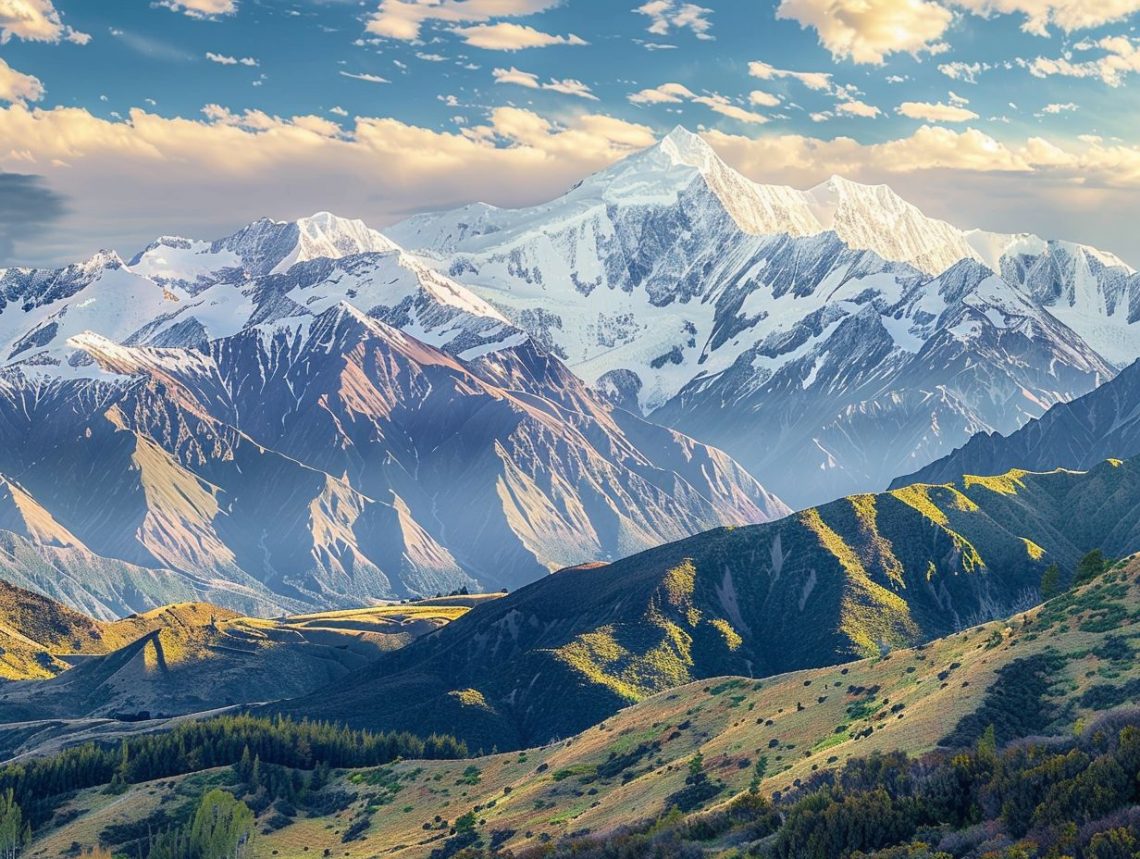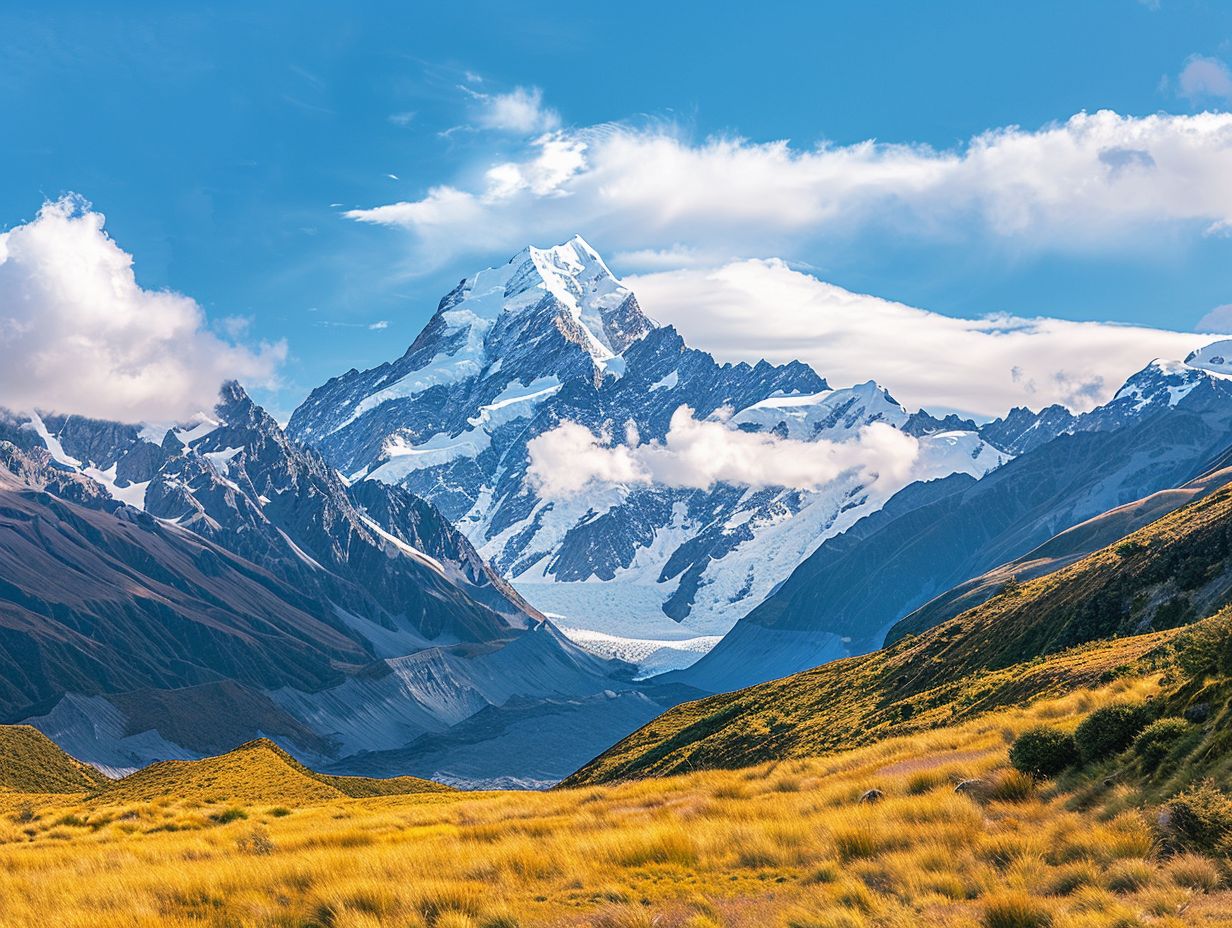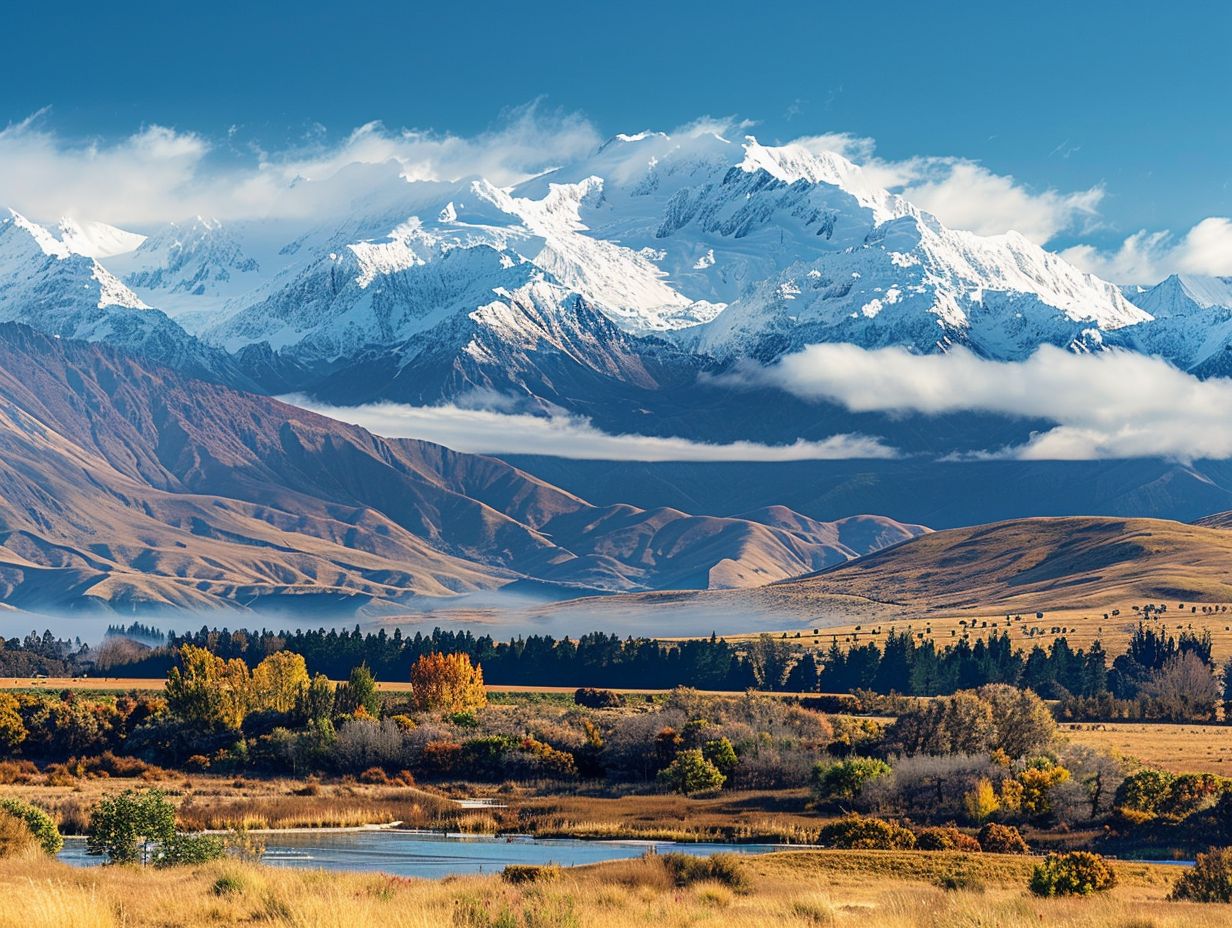
Tallest Mountains In New Zealand
New Zealand is home to some of the tallest mountains in the Southern Alps, each with its own unique charm and challenge for climbers.
From the majestic Mount Cook to the rugged Mount Tutoko, these peaks offer a thrilling adventure for those brave enough to conquer them.
We will explore the tallest mountains in New Zealand, their elevations, difficulty levels for climbing, and the best times to tackle these magnificent peaks.
Dive into the facts and figures about these awe-inspiring mountains in New Zealand.
Key Takeaways:

- Mount Cook, also known as Aoraki, is the tallest mountain in New Zealand and the entire Southern Alps range.
- The elevation of Mount Cook is 12,316 feet, making it a challenging climb for experienced mountaineers.
- The best time to climb the tallest mountains in New Zealand is during the summer months of December to February, when weather conditions are more favorable.
The Tallest Mountains in New Zealand
New Zealand boasts an impressive array of tall mountains, with peaks like Mount Cook (Aoraki), Mount Tasman, and Mount Silberhorn.
1. Mount Cook (Aoraki)
Mount Cook, also known as Aoraki in Maori legend, is the highest peak in New Zealand, located in the Southern Alps.
It holds cultural significance for the Ngāi Tahu tribe and has a rich history of exploration, including the feats of Sir Edmund Hillary.
The Maori legend of Aoraki tells the story of the mountain being one of the sons of Rakinui, the sky father, who was turned into stone.
This myth has made Mount Cook a sacred site for the Ngāi Tahu tribe, with the mountain seen as a link between the physical and spiritual worlds.
Renowned climbers from around the world are drawn to Mount Cook for its challenging terrain and stunning vistas.
The geological features of the mountain, with its rugged peaks and glaciers, attract adventure enthusiasts and scientists alike.
Conservation efforts in the region aim to protect this natural wonder for future generations.
2. Mount Tasman (Horokoau)
Mount Tasman, also known as Horokoau, is a prominent peak in the Southern Alps of New Zealand, showcasing the geological forces at work in the region.
Its formation is a testament to the tectonic activity that has shaped the landscape over millennia.
The mountain rises majestically to an elevation of 3,497 meters (11,473 feet) above sea level, offering a stunning sight for climbers and visitors alike.
It’s rugged terrain, sculpted by past glaciations and continual weathering, provides a challenging yet rewarding experience.
Mount Tasman stands in close proximity to its taller counterpart, Mount Cook, forming a breathtaking backdrop against the pristine blue skies and crystal-clear lakes.
3. Mount Dampier (Manirau)
Mount Dampier, also known as Manirau, presents a challenging yet rewarding climb in the Southern Alps of New Zealand.
The mountain is steeped in legends and stories, and its ascent is greatly influenced by the unpredictable weather conditions in the region.
Climbers who embark on the journey to conquer Mount Dampier are greeted by a rugged landscape that tests both their physical endurance and mental strength.
The steep slopes, icy crevasses, and unpredictable avalanches add a layer of danger to the ascent, making it a true test of skill and determination.
Local Maori legends speak of Manirau as a sacred place, believed to be the dwelling of powerful spirits.
These mystical stories add an aura of mystery and reverence to the mountain, reminding climbers of the deep cultural significance that surrounds this challenging peak.
Weather plays a crucial role in shaping the experience of climbers on Mount Dampier.
The ever-changing climate in the Southern Alps can bring sudden storms, low visibility, and frigid temperatures, posing serious obstacles.
4. Mount Silberhorn (Malte Brun)

Mount Silberhorn, also known as Malte Brun, is a majestic peak in the Southern Alps of New Zealand, characterized by its diverse flora and fauna.
The mountain serves as a habitat for unique plant and animal species adapted to the alpine environment.
The alpine environment of Mount Silberhorn is home to a variety of plant life, ranging from hardy alpine herbs and grasses to vibrant alpine wildflowers.
These plants have adapted to the harsh conditions of high altitude, including strong winds, freezing temperatures, and thin soil.
Adaptation is key for the survival of these species, allowing them to thrive in an environment that might seem uninhabitable to many.
5. Mount Hicks (Aorangi)
Mount Hicks, also known as Aorangi, carries rich Maori legends and historical significance in the Southern Alps of New Zealand.
The mountain’s name and stories reflect its cultural importance and deep-rooted connections to the indigenous heritage of the region.
These Maori legends often narrate tales of the mountain’s creation, attributing its formation to the mythical figures of the Maori cosmogony.
Aorangi’s towering presence is seen as a bridge between the earthly realm and the spiritual world, embodying the Maori belief in the interconnectedness of nature and spirituality.
6. Mount Aspiring (Tititea)
Mount Aspiring, known as Tititea in Maori, is a renowned peak in the Southern Alps of New Zealand, characterized by its majestic glaciers and challenging climbing routes.
The mountain offers a diverse range of experiences for mountaineers and adventurers.
It’s glaciated terrain creates a mesmerizing backdrop for climbers, with pristine ice formations and towering seracs that test even the most seasoned alpinists.
Mount Aspiring’s glaciated landscape boasts stunning features like crevasses, icefalls, and snowfields, providing both beauty and challenge.
Climbing opportunities range from technical ice routes to mixed climbing adventures, attracting climbers from around the world seeking a true test of their skills.
The history of climbing expeditions on Mount Aspiring is rich, with significant milestones marking the mountain’s conquest over the years.
These expeditions have added to the allure and mystique of the peak, enhancing its reputation as a formidable climbing destination.
The Maori name, Tititea, holds deep cultural significance, reflecting the spiritual connection of the indigenous people to the land.
Understanding the Maori heritage surrounding Mount Aspiring adds a layer of appreciation for its natural beauty and historical importance.
7. Mount Tutoko
Mount Tutoko stands as one of the highest peaks in the Southern Alps of New Zealand, offering breathtaking views and formidable challenges to climbers.
The mountain’s elevation and unpredictable weather conditions make it a sought-after destination for experienced mountaineers.
Located within the Fiordland National Park, Mount Tutoko rises to an impressive height of 2,723 meters above sea level, making it a daunting ascent.
It’s remote location adds an extra layer of challenge, requiring careful planning and preparation before embarking on an expedition.
The weather on Mount Tutoko can change rapidly, with high winds, heavy snowfall, and sudden storms posing immense risks to climbers.
8. Mount Haidinger (Pukeokaoka)
Mount Haidinger, or Pukeokaoka in Maori, has a unique climate and historical background in the Southern Alps of New Zealand.
The mountain’s weather patterns and past expeditions contribute to its allure for climbers and researchers alike.
Located in the Southern Alps, Mount Haidinger boasts a diverse climate ranging from snowy winters to mild summers.
It’s historical significance dates back to early mountaineering expeditions, with notable climbers attempting its challenging peaks.
Today, researchers are drawn to the mountain’s unique environment for studies on climate change, biodiversity, and geological formations.
9. Mount Teichelmann (Tasman)
Mount Teichelmann, also known as Tasman, holds a place of reverence in the Southern Alps of New Zealand, with legends and stories adding to its mystique.
The mountain’s climbing routes and historical narratives attract adventurers seeking both challenge and cultural enrichment.
Climbers are drawn to the rugged and awe-inspiring terrain of Mount Teichelmann, where steep cliffs and unpredictable weather conditions pose thrilling obstacles.
The mountain’s rich Maori heritage contributes to the profound sense of spirituality and connection that permeates the ascent.
Stories of ancient spirits roaming the peaks add an air of mystery that intertwines with the physical and mental rigors of the climb.
10. Mount La Perouse

Mount La Perouse stands as a testament to the geological forces at work in the Southern Alps of New Zealand, with Sir Edmund Hillary’s exploration adding to its historical legacy.
Standing at 3,459 meters, the mountain named after French explorer Jean-François de Galaup is one of the region’s prominent peaks.
It’s geological formations, such as the sharp ridges and glaciers, are a result of tectonic movements over millions of years.
The rocks found on the mountain range from ancient sedimentary layers to hardened volcanic deposits, providing a rich tapestry for geologists to study.
Facts and Figures about the Tallest Mountains in New Zealand
Exploring New Zealand’s tallest mountains unveils a diverse landscape, from Mount Ruapehu’s volcanic majesty to the pristine wilderness of Mount Aspiring National Park.
Each peak presents a unique challenge for climbers and enthusiasts.
The highest peak in New Zealand, Mount Cook, also known as Aoraki, stands at an impressive 3,724 meters above sea level, attracting seasoned climbers from around the globe.
It’s rugged terrain and unpredictable weather conditions offer a true test of skill and determination.
In contrast, the stunning Mount Taranaki, with its symmetrical volcanic cone, provides a mesmerizing backdrop for hikers and photographers.
For those seeking a more remote experience, the remote beauty of Mount Haast in the Southern Alps offers a sense of isolation and tranquility.
It’s challenging climbs and pristine alpine environment make it a coveted destination for adventurers looking to explore untouched wilderness.
Which Mountain is the Tallest in the Southern Alps?
Among the towering peaks of the Southern Alps, Mount Cook, also known as Aoraki, reigns supreme as the tallest mountain in New Zealand.
Named after the demigod in Maori mythology, who was believed to have scaled the heavens to become a mountain, Mount Cook holds immense cultural significance.
This majestic peak, reaching an impressive height of 3,724 meters, is not only a geographical marvel but a spiritual icon as well.
It is deeply ingrained in the lore and traditions of the Maori and Ngāi Tahu, with stories that reflect the deep connection between the land and its people.
What is the Elevation of the Tallest Mountain in New Zealand?
The tallest mountain in New Zealand, Mount Cook, reaches a majestic elevation that towers over the surrounding peaks of the Southern Alps.
This towering peak stands at an impressive height of 3,724 meters, making it not only the highest in New Zealand but also a landmark of significant prominence.
Mount Cook’s towering presence influences the landscape visibility of the surrounding areas, offering breathtaking panoramic views that stretch far and wide.
It’s height plays a crucial ecological role, influencing weather patterns, precipitation levels, and biodiversity in the region, creating a unique ecosystem.
What is the Difficulty Level of Climbing the Tallest Mountains in New Zealand?
Climbing the tallest mountains in New Zealand presents a formidable challenge to even the most experienced mountaineers.
Mount Cook, also known as Aoraki, is the highest peak in New Zealand, standing at an impressive 3,724 meters.
It’s sheer size and unpredictable weather conditions make it a challenging climb, requiring climbers to possess technical skills in ice and rock climbing.
The Southern Alps, where these majestic peaks reside, are famous for their steep terrain, crevasses, and ever-changing weather patterns, adding a layer of difficulty to any ascent.
Historically, these mountains have been the setting for legendary tales of daring expeditions and tragic accidents.
What is the Best Time to Climb the Tallest Mountains in New Zealand?

Choosing the optimal time to climb the tallest mountains in New Zealand involves consideration of the weather patterns, climate variations, and the seasonal flora and fauna.
Spring and summer are typically the preferred climbing seasons due to milder temperatures and more stable weather conditions.
During the warmer months, alpine meadows burst into a riot of colorful wildflowers, creating a breathtaking contrast against the snow-capped peaks.
The arrival of autumn signals a shift in weather, with cooler temperatures and the possibility of sudden storms.
Winter, with its heavy snowfall and extreme cold, poses significant challenges for climbers, limiting access to the peaks.
Frequently Asked Questions
1. What is the tallest mountain in New Zealand?
A: The tallest mountain in New Zealand is Mount Cook, also known as Aoraki, with an elevation of 3,724 meters (12,218 feet).
2. How many of the tallest mountains in New Zealand are located on the South Island?
A: Four out of the five tallest mountains in New Zealand are located on the South Island, including Mount Cook, Mount Tasman, Mount Dampier, and Mount Silberhorn.
3. Are there any active volcanoes among the tallest mountains in New Zealand?
A: No, all of the tallest mountains in New Zealand are non-volcanic and are part of the Southern Alps mountain range.
4. How long does it take to climb the tallest mountain in New Zealand?
A: The average time to summit Mount Cook is around 12-16 hours for experienced climbers, while it may take up to 3 days for those with less experience.
5. Do I need a permit to climb the tallest mountains in New Zealand?
A: Yes, a permit is required to climb Mount Cook and other peaks in the Aoraki/Mount Cook National Park. These can be obtained from the Department of Conservation.
6. Are there any guided tours available for climbing the tallest mountains in New Zealand?
A: Yes, there are several experienced mountaineering companies that offer guided tours to the tallest mountains in New Zealand, including Mount Cook and Mount Tasman.